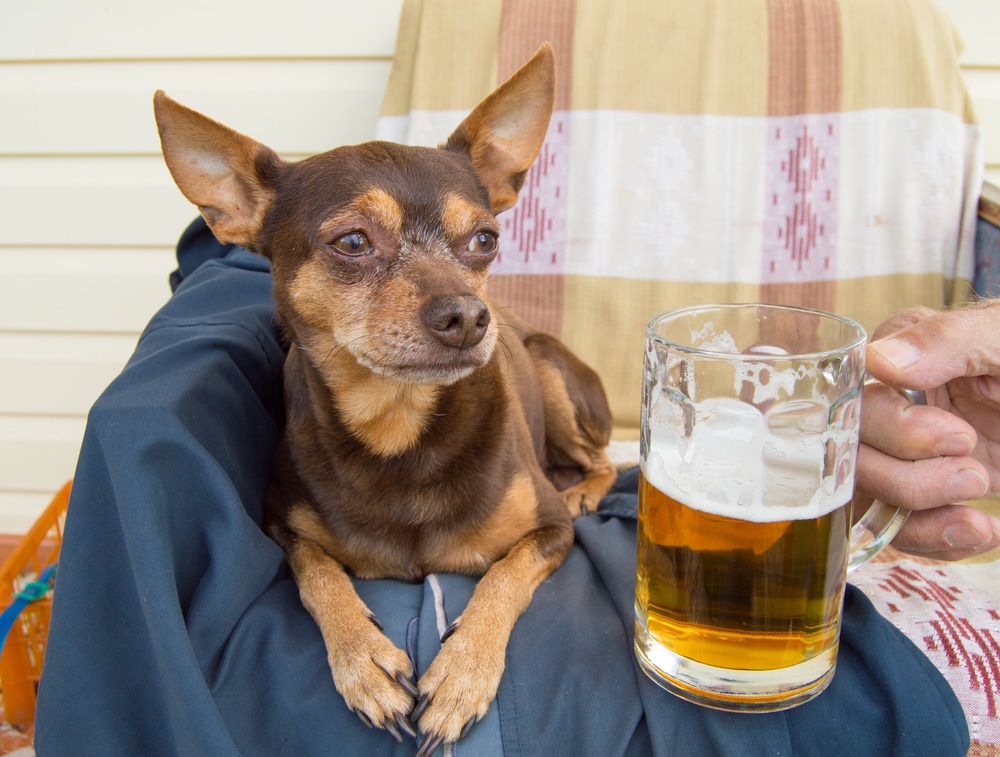Alcohol poisoning occurs when a dog gets in contact with or ingests products like rubbing alcohol, antifreeze, or mostly alcoholic drinks. Toxicity occurs rapidly as the alcohol can be quickly absorbed by the gastrointestinal tract or by the skin. So, how do you tell if your dog has alcohol poisoning?
Signs of alcohol poisoning in your dog are variable from the amount of alcohol it has taken and from its weight. The first signs include vomiting, incoordination, disorientation, and hypothermia.
Table of Contents
How Can Dogs Get In Contact With Alcohol?
One of the most ways dogs get in contact with alcohol is when they drink it. This happens in situations where the owners aren’t careful.
An owner may leave their wine or beer around the apartment, for example. Unsupervised, curious dogs may then go try it. Another possibility is someone tries to offer your dog alcohol, although this is far less likely.
Dogs can also get in contact with alcohol by licking spills. Some dog products also contain alcohol, which they can ingest or absorb through their skin. This is why we recommend only using vet-recommended dog products.
What Does Alcohol Do To Your Dog?
Alcohol is not a normal product that you can give to your dog. It is a problematic product for dogs that will affect them negatively.
It will affect your dog’s gastrointestinal tracts by damaging the stomach, the intestines, and the liver. Alcohol will also damage your dog’s central nervous system by causing them to lose control.
What Are The First Signs Of Alcohol Poisoning In Your Dog?

The first signs of alcohol poisoning in a dog will show through issues with their gastronomic tract, respiratory tract, and central nervous system.
The first sign will be vomiting. Your dog will appear very weak due to vomiting and loss of liquids in its body. Sometimes there might be diarrhea too.
Respiratory problems will also begin with difficulty in breathing. Your dog may inhale its vomit or saliva, of which there’s going to be a lot. Your dog may also lose bodily control and become disoriented. Hypothermia is also possible.
What Can You Do In This Emergency Situation?
In this emergency situation, you have to take your dog to the veterinary doctor. If you have seen that your dog has ingested alcohol or you mistakenly have used a product containing alcohol you should take your dog immediately to the veterinary doctor even if none of the signs of alcohol poisoning have appeared yet. Depending on the situation, you can also just contact your vet and see what they say to do.
Why Is Alcohol Poisoning Fatal To Dogs?
Alcohol poisoning is fatal for your dog because alcohol reacts quickly in your dog’s body. Alcohol quickly dehydrates dogs and damages their organs.
Moreover, alcohol in your dog’s body will cause a high level of acidity in its system. This starts with respiratory problems such as difficulty breathing, then slow heart rates and hypothermia. These conditions can cause a fatal heart attack, and this is why you have to take the dog immediately to the veterinary clinic if you’re noticing or suspect signs of alcohol poisoning.
What Can You Do As A Pet Owner To Prevent Alcohol Poisoning In Your Dog?
You can prevent these situations by being careful with your alcohol at the apartment. Don’t leave glasses of alcohol around the place or open bottles. Be careful when you have guests in the apartment. Make sure they know alcohol is off-limits for your dog.
Also, check the products you are using for your dog so you can be sure they don’t contain alcohol.
In Conclusion: How To Tell If Your Dog Has Alcohol Poisoning?
So, in conclusion, dogs and alcohol don’t mix. However, if they do mix, now you know what to look for and what to do.
So, have you ever had an alcohol scare with your dog? Let us know what happened and why in the comments below!
